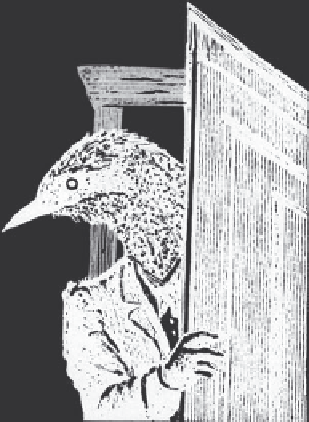Graphics Reference
In-Depth Information
I have thought of developing something based around the opening and closing of elevator
doors, each time revealing a new environment. This is not unlike the black frame of a i lm strip or
the black cloak of a magician. Something is concealed from us briel y and has changed.
This long diversion is not so much about doors as about using the space, and letting that
be part of the storytelling. In the condensed world of animation, anything can tell the story.
Telephones used to have such subtext, but mobiles and the ease of keeping in touch have
changed modern scenarios. Stairs have an inbuilt drama, again suggesting a journey, or a
mental descent or ascent, as well as a physical one.
Rushes
One pressure that new digital technology has eased
is the nightmare of watching rushes. With animation
it's a mockery to call them 'dailies' as that would be a
few seconds. The early series I worked on saw the i lm
sent of for processing not more than once a week. The
most responsible job on a i lm set then was the camera
loader. I have watched many a camera being opened
and a week's worth of i lm shoot across the l oor. No-
one got angry as there was no point. You cannot roll it
all up and shove it back in the camera quickly hoping
it didn't see the light, like the photographic equivalent
of the three-second rule of dropped food! Sometimes
the courier lost the cans as he travelled to the labs
across that bleakest of motorways, the M62. Some
sheep may at this very second be cogitating over lost
footage of
The Wind in the Willows.
There have been
occasions when the camera was opened, and there's
an echo unlike any other: no i lm. Terrifying, but not as
terrifying as watching a week's rushes with producers or clients unfamiliar with the details of
the scene or story, and whose casual comments cut deep. Shooting on digital lets you check
a shot immediately, and check it with the sound. You can see it cut into the previz, i tting into
the sequence. You can more informally share thoughts with producers and clients. Rushes
of yore held no such luxury. We sat in stony silence listening to the l icker of the projector,
screening your work in its most naked state. There was no sound to make sense of the gestures,
grotesque mouth movements or sudden movements, and without this motivation even the
best stop motion looks awful. The shots were likely to be in a random order, depriving some
actions of any sense and context. It was hard to sit there and not speak out the dialogue along
with the i lm, or to shout out that a certain gesture was done because it parallels something
later in the i lm. No such joy as the rushes sit there screaming their coldness. Never was an
animator more vulnerable or more prone to being destroyed. What you thought
was a beautiful piece of acting, in the cold silent light of a projection room
always looked absolutely ghastly, and I sweated with fear and nervousness as my
performance fell on stony ground. I would lose sleep the night before, being sick
with anxiety. It was made worse by being removed from that shot. The shots stand
alone. Sometimes an animator i lmed some naughty piece of business at the end
of the day. How l at it fell the next morning.
All my obsessions in one image:
a redrawn detail from a Max Ernst
collage.



Search WWH ::

Custom Search